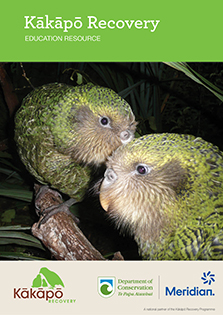Kākāpō Recovery education resources for teachers
Introduction
Use this resource to uncover why the kākāpō is so important to New Zealand.This resource has been developed by our partners Meridian Energy.
This resource introduces students to:
- kākāpō ecology: where they live, what they eat, their adaptations, and how they stay alive
- kākāpō challenges: kākāpō threats and how people contribute to these
- kākāpō conservation: the role of people in protecting kākāpō.
Download the resource
Kākāpō Recovery education resource (PDF, 2,693K)
Kākāpō infographic
This infographic explains what a kākāpō is, why they are so vulnerable and how people are working together to help them survive.
Kākāpō infographic (PDF, 495K)
Learning outcomes
Using this resource, students can:
- build knowledge and understanding of kākāpō
- raise awareness of the current situation for kākāpō
- understand how people are involved in kākāpō recovery
- contribute to a positive future for kākāpō.
Curriculum links
Level 1-4 Science
Living World: Ecology
- Recognise that living things are suited to their particular habitats.
Living World: Life processes
- Recognise that living things are suited to their particular habitats.
Nature of Science: Investigating in science
- Ask questions, find evidence, explore simple models and carry out investigations to develop simple explanations.
Science capabilities:
- Gather and interpret data
- Use evidence
- Interpret representations
- Engage with science
Level 1-4 Social science
- Understand how people make decisions about access to and use of resources
- Understand how formal and informal groups make decisions that influence communities
Level 1-4 Mathematics and statistics
- Statistical Investigation: Conduct investigations using the statistical enquiry cycle: gathering, sorting, and displaying multivariate category and whole-number data and simple time-series data to answer questions.
- Identifying patterns and trends in context within and between data sets
Contact
For questions or feedback about these resources, email engagement@doc.govt.nz.




